

3 Strategies for Teaching English Learners Academic Language. A common misconception among teachers is that if a student can speak English fluently, he or she does not need extra accommodations in order to grasp the curriculum.

In reality, many students struggle with academic language because their exposure to language outside of school does not include advanced words and phrases. The transition to “school talk” poses a particular challenge for English Learners (ELs) as they must simultaneously develop everyday language already familiar to their monolingual peers, along with academic language skills (O’Brien and Leighton, 2015). Without exposure to advanced English language skills at home, ELs face double the demands of language learning. Increasing numbers of EL students attending schools across the country have made it an educational imperative that instruction and assessment directly promote students’ academic language proficiency. Figure 2.2. Building Academic Language at Palmer's College. Vocab teaching: summary for busy teachers – Hearts and Minds. [Here is a summary of what I’ve learned from my reading on vocabulary teaching, with some of my own thoughts sprinkled into the mix.
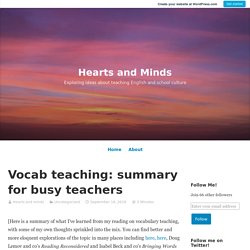
You can find better and more eloquent explorations of the topic in many places including here, here, Doug Lemov and co’s Reading Reconsidered and Isabel Beck and co’s Bringing Words to Life.] There are two main types of vocabulary instruction: explicit and implicit. Explicit teaching requires investing time in thorough teaching of the word. To do it well, we must think carefully about what the best words to teach are. Implicit instruction is the quick teaching of words to aid textual understanding. How to Teach Vocabulary Acquisition - TeachLikeThis.
Teaching Vocabulary through Context and Examples: “3-2-1 Go!” 182 VocabularyTiers. Vocabulary chapter 2 word tiers. Tier 2 vocabulary (Sublists in order of frequency) Tier 2 Vocabulary Lists by Grade Levels (K-12) Skip to Main Content District Home Select a School Translate Sign In search Hyde Park Schools Hyde Park, New York 12538 The Hyde Park Central School District empowers our community to strive for excellence and embrace the opportunities of our globally connected world.
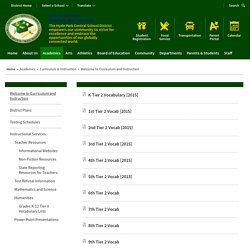
Facilities& Tech RequestsFoodServiceTransportationParentPortalCalendar Menu Pages. Choosing Words to Teach (Elementary) The teacher's edition for a fourth-grade anthology suggests teaching the following words before inviting students to read an excerpt from Charlotte's Web (White, 1952): comfort, cunning, endure, friendless, frolic, lonely, soaked, and stealthily.
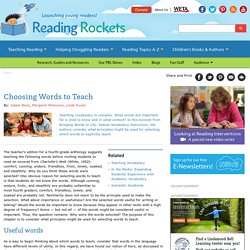
Why do you think these words were selected? One obvious reason for selecting words to teach is that students do not know the words. Although cunning, endure, frolic, and stealthily are probably unfamiliar to most fourth graders, comfort, friendless, lonely, and soaked are probably not. Familiarity does not seem to be the principle used to make the selection. A17. Tier 2 Words: Words that Make a Difference (Secondary) The goal of this article is to share a process for teaching ELs high-utility academic words, known as Tier 2 words.

Practices that develop vocabulary include:Research Says Read-alouds where the teacher explains and discusses new vocabularyReading and writing activities that encourage the use of new wordsTeacher modeling of new and high-utility vocabulary usage (Blachowicz et al., 2006; Graves, 2007; Chung, 2012)Using the target words in sentences that construct a narrative (August et al., 2005).Multiple exposures to target words within a variety of contexts (Blachowicz et al., 2006; Beck et al., 2002; Carlo et al., 2008) I have taken these research-backed practices and synthesized them into a system of teaching high-utility Tier 2 vocabulary words.
Academic Vocabulary. Four Practical Principles for Enhancing Vocabulary Instruction. Literacy researchers and teachers have shown an increased interest in vocabulary instruction over the past decade.
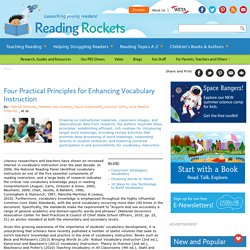
In 2000, the National Reading Panel identified vocabulary instruction as one of the five essential components of reading instruction, and a large body of research indicates the critical role vocabulary knowledge plays in reading comprehension (August, Carlo, Dressler & Snow, 2005; Baumann, 2009; Chall, Jacobs, & Baldwin, 1990; Cunningham & Stanovich, 1997, Mancilla-Martinez & Lesaux, 2010). Furthermore, vocabulary knowledge is emphasized throughout the highly influential Common Core State Standards, with the word vocabulary occurring more than 150 times in the document.
Active Practice: The Key to Vocabulary. We’ve just finished our chapter on vocabulary in Reading Reconsidered.
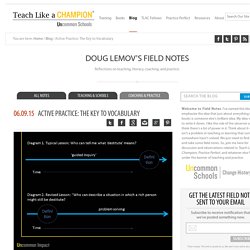
In it, we describe ways to teach new words directly (Explicit Vocabulary Instruction) and ways to increase how much word knowledge students absorb from reading words in texts (Implicit Vocabulary Instruction). The following is from our discussion of Explicit Vocabulary Instruction and talks about the key role of Active Practice—causing students to practice applying and using a word. Why Reading Aloud to Students is So Critical to Vocabulary. Last night, after reading aloud to my daughter and tucking her in, I was mopping up a bit of work from the day and came across a reminder of this observation by Isabel Beck: “The source of later vocabulary learning shifts [as students get older] to written texts–what children read [as opposed to what they hear].
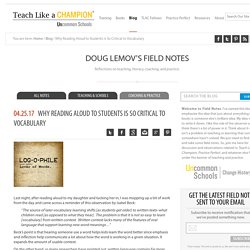
The problem is that it is not so easy to learn [vocabulary] from written context. Written context lacks many of the features of oral language that support learning new word meanings…” Beck’s point is that hearing someone use a word helps kids learn the word better since emphasis and inflection help communicate a lot about how the word is working in a given situation.
It expands the amount of usable context. On the other hand, as many researchers have pointed out, written language contains far more vocabulary words than oral language. On Vocabulary: How to write a definition. My team and I have been on a vocabulary binge, watching lesson after lesson to pick up best practices and commonalities among teachers.
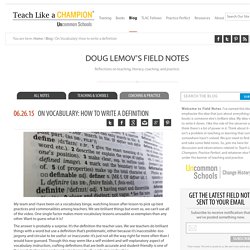
We see brilliant things but even so, we can’t use all of the video. One single factor makes more vocabulary lessons unusable as exemplars than any other. Want to guess what it is? Building Academic Vocabulary: A Postcard from Jo Facer's Classroom. A few weeks ago we shot video at the Michaela School in London- truly a thought-provoking and inspirational place.
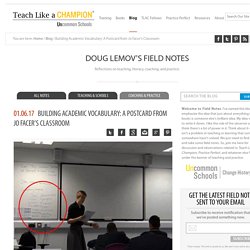
I’ve just started in watching the footage, beginning with Jo Facer’s English class, and have already found a dozen moments I’m going to cut video of. But for now I just want to share a photo of Jo’s class. In this lesson, she and her pupils are reading Othello. It’s a rich and rigorous discussion. In one moment that I love, Facer is reading aloud from the text. Facer: Notice that the Duke of Venice asks Othello: “What can you say?”
Lamar: “It shows the disrespect that Brabantio has for Othello.” From Reading Reconsidered: On Teaching Vocabulary [Implicit vs. Explicit] Another excerpt coming at you from the throes of finalizing Reading Reconsidered. This excerpt is on our two-pronged approach to Vocabulary. To command words is to master both their breadth and their depth. Reading for anything more than basic comprehension relies on the a reader’s capacity to understand both a large number of words (breadth) and also the subtleties and the nuances of many of those words (depth), even when those words change their meaning with the setting. As a result, effective vocabulary instruction is one of the greatest and most important challenges facing schools and teachers today.
It must prepare students to master both breadth and depth in both production and reception of language—in writing and in reading. Express 9.17 - Building Academic Vocabulary and Concepts, Brick by Brick. Total Physical Response Vocabulary. Tips For Teaching Hard Vocabulary Words [Marzano-Based Worksheet] Tips For Building Student Vocabulary [Using Paint Chips] Common core State Standards ELA: English Language Arts L: Language Standards 6-12 11-12: 11th & 12th Grades 4b: Determine or clarify the meaning of unknown and multiple-meaning words andphrases based on grades 11-12 reading and content, choosing flexibly from arange of strategies.a.
Use context (e.g., the overall meaning of a sentence, paragraph, or text; awordâ\x80\x99s position or function in a sentence) as a clue to the meaning of a wordor phrase.b. Identify and correctly use patterns of word changes that indicate differentmeanings or parts of speech (e.g., conceive, conception, conceivable).c. Consult general and specialized reference materials (e.g., dictionaries,glossaries, thesauruses), both print and digital, to find the pronunciationof a word or determine or clarify its precise meaning, its part of speech, itsetymology, or its standard usage.d. Download Common Core State Standards (PDF 1.2 MB) 7 Step Vocabulary Method For ELL Students. Joe, Good classroom discussion about vocabulary, however, it is not the 7-Steps of RETELL or it’s foundation model ExC-ELL. Good during reading technique or after reading word study, but for preteaching, it requires too much background knowledge an is not a Tier 2 vocabulary phrase.
Improving Young Student Vocabulary With High Level Conversation. Common core State Standards ELA: English Language Arts L: Language Standards K-\x80\x935 2: 2nd Grade 5: Demonstrate understanding of word relationshipsand nuances in word meanings.a. Identify real-life connections between wordsand their use (e.g., describe foods that arespicy or juicy).b. Distinguish shades of meaning among closelyrelated verbs (e.g., toss, throw, hurl) and closelyrelated adjectives (e.g., thin, slender, skinny,scrawny). Extending Lesson Understanding: Vocabulary Development [Vocab Clue Word Activity] Promoting Independence For ELLs: Walls That Talk. Use Hand Movements To Clarify Language. Say It with Your Hands Transcript Speaker 1: We're going to do it together.
One thing that I use to support all my learners including my English language learners is to use hand movements, so they understand better what I'm talking about. Let's read a little bit more here. People are different. Some people are short, some have brown eyes. Speaker 2: The wings. Speaker 1: What did you say, the rings? Speaker 1: The wings. Speaker 3: Big, and the shape. Speaker 1: The shape of them. Adding Content Into Classroom Management Techniques: Managing Transitions. Erica Woolway: Borrowing from a TLAC Video to Build Vocabulary At Home.
Vocab practice activities. Vocabulary Graphic Organizers. Vocabulary Map Template - MIDDLE SCHOOL MATTERS. Explanation for Vocabulary Map Template: